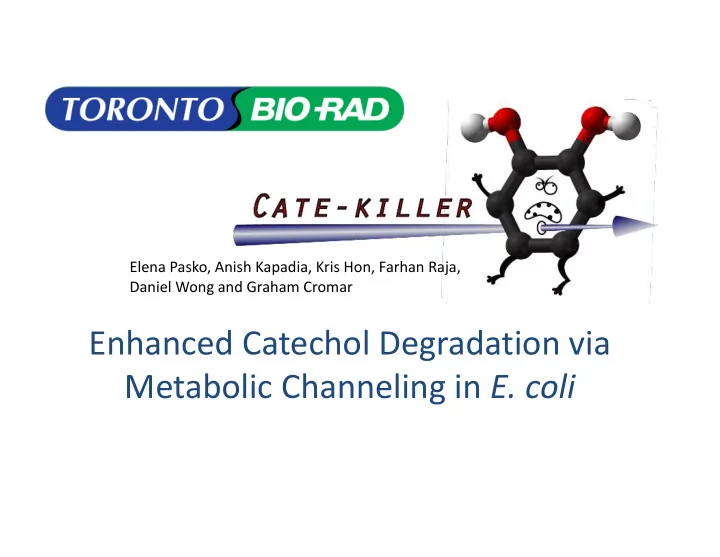

Elena Pasko, Anish Kapadia, Kris Hon, Farhan Raja, Daniel Wong and Graham Cromar Enhanced Catechol Degradation via Metabolic Channeling in E. coli
Oil Sands are an important, naturally occurring petroleum resource Bitumen, a heavy and very viscous form of crude oil Mixed with sand and clay = oil sands
Major contaminants: • Hydrocarbons • Naphthenic Acid • Heavy Metals Are toxic to: aquatic organisms and animals
Polycyclic aromatic hydrocarbons can be degraded by some bacteria • e.g. Pseudomonas Catechol Putida • Generates a common toxic intermediate‐ Catechol • Reaction rates are typically slow
Metabolic channeling can overcome some limitations by shuttling intermediates between consecutive enzymes Protein Scaffolds Immobilizing Enzymes Fusion proteins Dueber et al. Nat Biotech 27: 753-759 Conrado et ak. Curr. Opin. In Biotech. 19: 492-499
Experiments done in silico predict it is possible to overcome pathway limitations by co‐localizing some pairs of enzymes. Work by Chris Sanford. No channelling Channelling
Aims Augment the existing capabilities of an aromatic hydrocarbon degrading microbe (e.g. Pseudomonas putida ) using metabolic channeling. We will first demonstrate this process in E.coli using pathway reconstruction. 1. Develop a generalizable methodology for the analysis, modeling and prediction of enzyme candidates for metabolic channeling. 2. Demonstrate metabolic channeling of a relevant bioremediation pathway in a model organism ( Escherichia coli ). 3. Further characterize of our encapsulin micro‐compartment.
Ortho‐cleavage of catechol is amenable to metabolic channeling 1. Pathway is absent in E.coli therefore any breakdown of catechol is the result of the reconstructed pathway. 2. E.coli is the chassis of choice. Other parts in the library including, importantly, our encapsulator are designed and available. 3. There is a genome‐scale model of E.coli metabolism.
Pairs of enzymes will be fused in a series of pathway reconstructions
CFU / ml Time hrs
E.Coli DH5a is sensitive to catechol Untreated (Control) Treated 50mM Catechol
Reconstituted pathway leads to Catechol degradation in E. coli
Flux Balance Analysis (FBA) was used to predict the effect of our manipulations on E.coli metabolism • Flux Balance Analysis: – Models stoichiometric reaction system of cell – Determines metabolic flux through reaction network • FBA used to determine growth rate for specified uptake levels of glucose and catechol • Catechol transport and degredation reactions added to modeled E. Coli metabolism flux model (iJR904). Catechol + O 2 + H 2 O + CoA --> Acetyl-CoA + Succinate
Catechol degradation increases growth rate given certain conditions Objective #1 1. Determine optimal glucose & catechol uptake rates
Flux predominantly influences the TCA cycle • Able to identify reactions where there is a change in flux variability or magnitude when catechol degradation pathway is introduced Objective #2 Determine what reaction pathways will be affected by incorporation of catechol degradation pathway into E. Coli.
FBA helps us predict conditions that may further optimize catechol degradation Oxygen splurging Genetic knockouts Assumes we can solve the problems associated with enzyme assembly...
Molecular modeling is being used to approximate expression levels based on rates of subunit assembly Need to determine ratio of monomer‐to‐multimer for each • enzyme ΔH = ‐31,918 kJ/mol K = 390,780 mol ‐1 Catechol 1,2‐Dioxygenase (Dimer) Need to model all possible multimer dissassociation • arrangements We also need to determine the expected level of linked enzyme • formation in relation to unlinked and tangle formation
We coupled our project with a relevant human practices component Teaching in China! Our goals: • Teach synthetic biology. • Experience life in China. • Have fun! Toronto iGEM team members in Guangzhou China 2010
We developed and delivered a six part course focusing on key concepts Units: Evolutionary biology Cell biology Molecular biology Bioinformatics Systems biology Synthetic biology Note: Students were exposed to basic engineering principles in workshops by other UTACCEL seminar leaders. UTACCEL Leaders and participants
China is a source of increasing demand for oil. Daily Crude Oil demand of Canada, China, India, Japan, and USA Thousand Barrels per day (kb/d) Source: Joint Oil Data Initiative http://www.jodidata.org/
Transforming the world takes more than a vision statement Transforming the world through clean energy and technology is fine. Doing it while meeting basic needs is the challenge! Making some new friends along the way helps!
Summary of Results • Identified a relevant bioremediation pathway that is amenable to metabolic channeling. • Created six biobrick parts representing the pathway from P. putida . • Modeled the likely effects of knocking in this pathway in a genome scale model of E. Coli metabolism (increase in growth rate). We have also explored the required amounts of expressed monomers based on molecular dynamics of their assembly. • Conducted baseline experiments to allow us to measure the effects of catechol on our mutants. • Continued to characterize our encapsulin part, demonstrating it’s expression in an IPTG inducible construct. • Contributed significantly to human practices through our outreach initiative.
Acknowledgements Parkinson Lab • – Farhan Raja – Stacy Hung – Yen Leung – Kenny Zhan Advisors • – Dr. John Parkinson – Dr. Alan Davidson – Dr. Amin Zia
Metabolic channeling can be used to overcome some of these limitations Shuttles metabolic intermediates between the active sites of consecutive enzymes accelerating unfavourable reactions Some naturally occurring examples are: Tryptophan synthase Bacterial microcompartments
Encapsulation of enzymes may provide an enhancement to channeling
Multimeric Enzymes • Challenges – Most crystallography files only have partial multimers ZDOCK – Some enzymes lack crystallography files • Homology modeling
We also need to determine the expected level of linked enzyme formation • In relation to tangle • In relation to unlinked formation enzyme formation
Recommend
More recommend